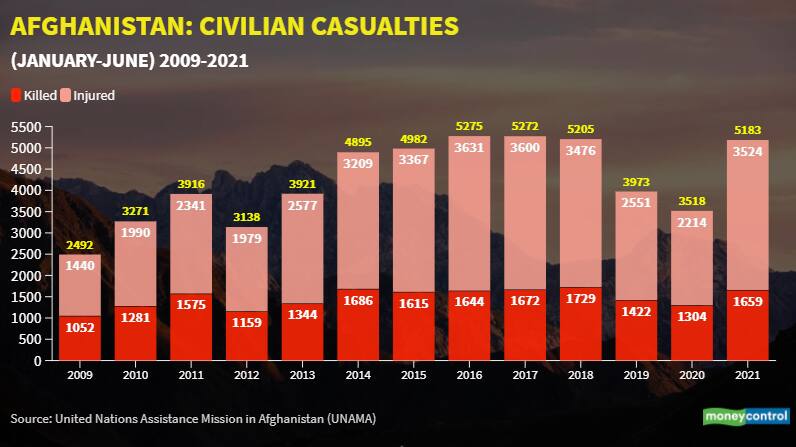



Civilian casualties in Afghanistan in the first half of this year jumped to the highest (in terms of percentage increase) in more than a decade, mainly because of anti-government elements, before Taliban insurgents swiftly seized power using threats, lures, propaganda and psychological warfare, as reports suggest.
The rapid advance of Taliban -- the world’s deadliest terrorist group in 2019 according to the Global Terrorism Index 2020 -- hastened the departure of Afghanistan President Ashraf Ghani, who said he fled “to avoid bloodshed” as he believed “countless patriots would be martyred and the city of Kabul would be destroyed” if he had stayed behind.
Violence was already rising. Data suggest that the first half of 2021 civilian casualties rose 47 percent to 5,183 from 3,518 in the same period of 2020, according to the United Nations Assistance Mission in Afghanistan (UNAMA).
This is the highest percentage increase recorded in the first six months of a year over the same period of the previous year, since 2009.
Images and videos on social media from the war-torn nation show Afghan nationals desperately trying to escape the country, fearing the takeover by the radical regime.
The reemergence of Taliban’s Islamic Emirate has revived horrifying memories of the past, when civilians were subjected to grave human rights violations and crimes, especially those perpetrated against women and children.

“UNAMA is concerned by the increased number of civilian casualties that have occurred since the announcements by international military forces in April, and then commencement shortly thereafter, of their withdrawal from Afghanistan, after which the Taliban captured a significant number of district administrative centres,” the UNAMA report notes.
Casualties increased significantly after the announcement of the withdrawal. In May and June this year, 2,392 civilian casualties were recorded, nearly as many as those reported in the entire preceding four months.
'Reversing the trend of the past'
In the first half of this year, 1,659 civilians were killed and 3,524 were injured, “reversing the trend of the past four years of decreasing civilian casualties in the first six months of the year, with civilian casualties rising again to the record levels seen in the first six months of 2014 to 2018,” the report said.
Figures documented between January 1, 2021 and June 30, 2021, show a record number of girls and women being killed and injured, as well as overall child casualties.
The number of girls and women killed or injured nearly doubled in 2021, compared with the first six months of 2020, the report highlights. Likewise, boy civilian casualties increased by 36 percent, and male civilian casualties by 35 percent over the same period.
As many as 727 women casualties (219 killed and 508 injured) were reported in the first six months of the year, an increase of 82 percent, while child casualties rose 55 percent to 1,682 (468 killed and 1,214 injured).
Civilians bear the brunt
“This was the most civilian casualties caused by non-suicide IEDs in the first six months of a year since UNAMA began systematic documentation of civilian casualties in Afghanistan in 2009,” the report states.
Anti-government elements were responsible for 64 percent of the total civilian casualties, followed by pro-government forces (25 percent); while 11 percent were attributed to crossfire, mainly between Taliban and Afghan national security forces.

Casualties inflicted by anti-government elements increased 63 percent compared with the first six months of 2020, while those by pro-government forces 30 percent.
The international agency raised concerns over attacks on healthcare and education facilities as well as workers in the first six months of 2021. Sixteen incidents of direct targeting of schools and educational personnel were reported; in addition, 26 incidents were recorded in which schools/educational personnel were incidentally impacted.
Likewise, 28 incidents of direct targeting of healthcare facilities and workers were documented in the first six months of this year, and 24 incidents registered where facilities and workers were incidentally impacted.
The shift in “territorial control” during the first half of 2021 has led to “concerning developments,” the UNAMA report states.
Between May and June 2021, “destruction and looting of civilian homes, schools, clinics, electricity and mobile phone towers, city water supplies, bridges, shops, and residential apartment buildings,” were reported. The vast majority of incidents of intentional destruction of civilian property that UNAMA verified were attributed to or done with the complicity of Taliban fighters after they took control of a new area,” the report said.
The loss over a decade
More than 40,000 lives have been lost and over 75,000 have been injured over a decade (between January 2009 and June 2021), documented data suggests.


“Ever since 2014, when the United States and its allies ended combat operations—although they continued using air power—the Taliban steadily seized incrementally greater tracts of rural territory,” writes Praveen Swami. “The Afghan army’s 215 Corps, stationed in Helmand, had almost collapsed in 2017—forcing the United States to send in troops, ostensibly on a ‘training’ mission.”
By then, the Taliban had made a comeback in rural districts, surrounding the major cities. As the US army reduced their presence and pulled out from Afghanistan, the Taliban’s were swift to gain control and capture the remaining areas.
Afghanistan was the worst-hit country by terrorism in 2019, reporting the highest economic cost of terrorism, equivalent to 16.7 percent of its Gross Domestic Product, according to the Global Terrorism Index 2020.
“No other country in 2019 experienced a cost of terrorism greater than four percent of its GDP,” Syria was second (3.4 percent) followed by Nigeria (2.4 percent), the report said.
Discover the latest Business News, Sensex, and Nifty updates. Obtain Personal Finance insights, tax queries, and expert opinions on Moneycontrol or download the Moneycontrol App to stay updated!
Find the best of Al News in one place, specially curated for you every weekend.
Stay on top of the latest tech trends and biggest startup news.